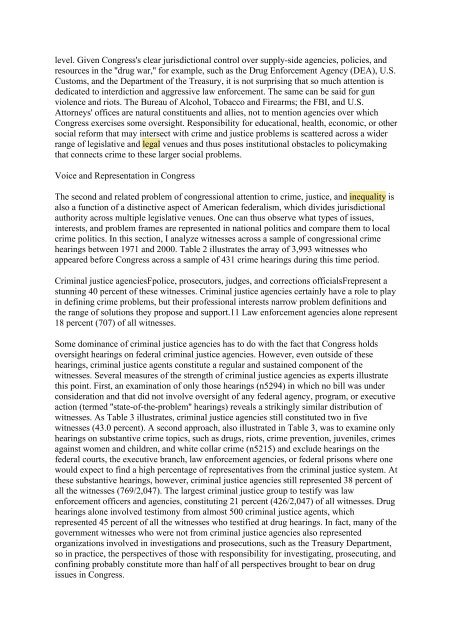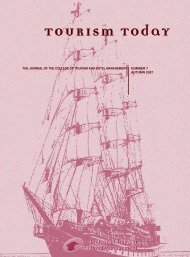The Invisible Black Victim: How American Federalism Perpetuates ...
The Invisible Black Victim: How American Federalism Perpetuates ...
The Invisible Black Victim: How American Federalism Perpetuates ...
Create successful ePaper yourself
Turn your PDF publications into a flip-book with our unique Google optimized e-Paper software.
level. Given Congress's clear jurisdictional control over supply-side agencies, policies, and<br />
resources in the ''drug war,'' for example, such as the Drug Enforcement Agency (DEA), U.S.<br />
Customs, and the Department of the Treasury, it is not surprising that so much attention is<br />
dedicated to interdiction and aggressive law enforcement. <strong>The</strong> same can be said for gun<br />
violence and riots. <strong>The</strong> Bureau of Alcohol, Tobacco and Firearms; the FBI, and U.S.<br />
Attorneys' offices are natural constituents and allies, not to mention agencies over which<br />
Congress exercises some oversight. Responsibility for educational, health, economic, or other<br />
social reform that may intersect with crime and justice problems is scattered across a wider<br />
range of legislative and legal venues and thus poses institutional obstacles to policymaking<br />
that connects crime to these larger social problems.<br />
Voice and Representation in Congress<br />
<strong>The</strong> second and related problem of congressional attention to crime, justice, and inequality is<br />
also a function of a distinctive aspect of <strong>American</strong> federalism, which divides jurisdictional<br />
authority across multiple legislative venues. One can thus observe what types of issues,<br />
interests, and problem frames are represented in national politics and compare them to local<br />
crime politics. In this section, I analyze witnesses across a sample of congressional crime<br />
hearings between 1971 and 2000. Table 2 illustrates the array of 3,993 witnesses who<br />
appeared before Congress across a sample of 431 crime hearings during this time period.<br />
Criminal justice agenciesFpolice, prosecutors, judges, and corrections officialsFrepresent a<br />
stunning 40 percent of these witnesses. Criminal justice agencies certainly have a role to play<br />
in defining crime problems, but their professional interests narrow problem definitions and<br />
the range of solutions they propose and support.11 Law enforcement agencies alone represent<br />
18 percent (707) of all witnesses.<br />
Some dominance of criminal justice agencies has to do with the fact that Congress holds<br />
oversight hearings on federal criminal justice agencies. <strong>How</strong>ever, even outside of these<br />
hearings, criminal justice agents constitute a regular and sustained component of the<br />
witnesses. Several measures of the strength of criminal justice agencies as experts illustrate<br />
this point. First, an examination of only those hearings (n5294) in which no bill was under<br />
consideration and that did not involve oversight of any federal agency, program, or executive<br />
action (termed ''state-of-the-problem'' hearings) reveals a strikingly similar distribution of<br />
witnesses. As Table 3 illustrates, criminal justice agencies still constituted two in five<br />
witnesses (43.0 percent). A second approach, also illustrated in Table 3, was to examine only<br />
hearings on substantive crime topics, such as drugs, riots, crime prevention, juveniles, crimes<br />
against women and children, and white collar crime (n5215) and exclude hearings on the<br />
federal courts, the executive branch, law enforcement agencies, or federal prisons where one<br />
would expect to find a high percentage of representatives from the criminal justice system. At<br />
these substantive hearings, however, criminal justice agencies still represented 38 percent of<br />
all the witnesses (769/2,047). <strong>The</strong> largest criminal justice group to testify was law<br />
enforcement officers and agencies, constituting 21 percent (426/2,047) of all witnesses. Drug<br />
hearings alone involved testimony from almost 500 criminal justice agents, which<br />
represented 45 percent of all the witnesses who testified at drug hearings. In fact, many of the<br />
government witnesses who were not from criminal justice agencies also represented<br />
organizations involved in investigations and prosecutions, such as the Treasury Department,<br />
so in practice, the perspectives of those with responsibility for investigating, prosecuting, and<br />
confining probably constitute more than half of all perspectives brought to bear on drug<br />
issues in Congress.














